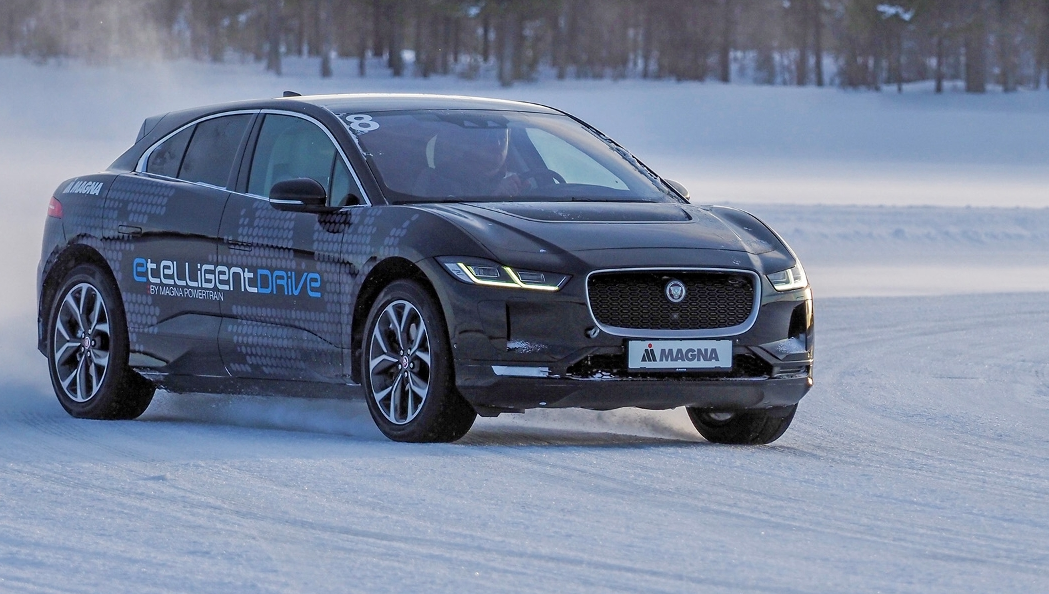 麦格纳正在加强内部研发力量,并积极建立合作伙伴关系,保证公司能在汽车电气化进程中处于领先地位。图为一辆最近正在进行冬季测试的电动推进系统演示车。(麦格纳)
麦格纳正在加强内部研发力量,并积极建立合作伙伴关系,保证公司能在汽车电气化进程中处于领先地位。图为一辆最近正在进行冬季测试的电动推进系统演示车。(麦格纳) 麦格纳公司新上任的执行副总裁Sherif Marakby 是汽车行业中最有经验的电气化专家之一。(Keith Tolman/VIS)
麦格纳公司新上任的执行副总裁Sherif Marakby 是汽车行业中最有经验的电气化专家之一。(Keith Tolman/VIS) 麦格纳最近与LG共同成立的合资公司将建立在供应商自行开发的高级电驱动上。该系统集成的电机额定峰值功率高达 125 kW,是与伊利诺伊理工学院和威斯康星大学麦迪逊分校合作研发。研发目标是将现有电机的功率密度提高 8 倍,且成本砍到一半。(麦格纳)
麦格纳最近与LG共同成立的合资公司将建立在供应商自行开发的高级电驱动上。该系统集成的电机额定峰值功率高达 125 kW,是与伊利诺伊理工学院和威斯康星大学麦迪逊分校合作研发。研发目标是将现有电机的功率密度提高 8 倍,且成本砍到一半。(麦格纳) 麦格纳动力总成集团战略负责人 Ron Frawley 表示:“OEM客户已经向麦格纳提出了多达40种的动力总成配置需求。”
麦格纳动力总成集团战略负责人 Ron Frawley 表示:“OEM客户已经向麦格纳提出了多达40种的动力总成配置需求。”
在 CES 2021期间的一次在线媒体会议上,麦格纳动力总成 (Magna Powertrain) 高管表示,汽车行业正在向“全电动化”的终极目标不断迈进,这将给汽车产品开发和技术管理带来前所未有的复杂性。
麦格纳最近上任的执行副总裁 Sherif Marakby 表示,公司在轻量化结构、驾驶员辅助传感器技术、主动空气动力系统、动力总成/传动系统和整车装配等领域具有传统优势,这将为我们进军“车辆电动化”和“自动驾驶解决方案”领域奠定基础。Markaby 在汽车行业的经验丰富,曾负责福特汽车的混动和电动汽车项目。在加入麦格纳之前,他还是福特汽车爱迪生自动驾驶研发团队 (Team Edison) 的负责人。
Markaby 指出,哪怕作为全球最大的一级供应商之一,我们也不能“单打独斗”。他对CES的观众表示,“合作关系非常关键。”并简要介绍了,麦格纳目前与 LG(电机、逆变器、电池)、Innoviz Technologies(激光雷达)、Uhnder(数字雷达)以及中国 HASCO(电驱动系统)等公司的战略关系。然而,麦格纳动力总成集团战略负责人 Ron Frawley 表示,哪怕有这些合作伙伴的帮助,从目前以内燃机为主的市场转向一个全电动的未来,仍然将对各级工程师提出了巨大挑战。
“截至 2021 年,’传统’动力总成市场有 8 到 10 种基本动力总成配置。”Frawley指出,但受到全球空气质量法规的影响,发动机/变速器组合的总数有所下降。他引用了麦格纳的预测数据称,到 2030 年,电气化系统在全部动力总成中的比例将达到 50%,其中各类混合动力汽车将占主要份额而纯电动汽车将占到 12 到 16%,非混合动力内燃机车型仍将在全部动力总成中占据 23% 的份额。
Frawley 解释说,这种旷日持久、代价高昂的转型“让形势更加复杂多变”。转型将首先发力于如何在现有架构上支持PHEV、HEV和EV动力系统。此外还包括提供“各种功率等级”的电机。在此背景下,麦格纳收到了来自OEM的各种各样的需求,功率等级从 15 kW 到 300 kW,工作电压从 48 V 到800 V 不等。这些电机可以安装在车辆的 5 个不同位置,包括 BSG、电动车桥、甚至是轮端驱动等等。
“电动全轮驱动和四轮驱动的情况也必须考虑,”Frawley 说,“这意味着道路上的许多车辆将装配不止一个电机和逆变器,以及不止一个电动动力总成系统。毫无疑问,这都会让产品研发愈发复杂。目前,OEM客户已经向麦格纳提出了多达40种的动力总成配置需求。”
Frawley 断言,电机和逆变器将在电动动力总成系统的经济性中起到重要作用,并为电驱动系统提供“高达 70% 的附加值”。
作者:Lindsay Brooke
来源:SAE《汽车工程》
The industry’s transition to electrified, and ultimately fully electric, vehicles is bringing far greater complexity in product development and technology-management overall, according to Magna Powertrain executives, speaking in an online media session during the 2021 Consumer Electronics Show (CES).
Magna’s traditional strengths in lightweight structures, driver-assistance sensor technologies, active aerodynamic systems, powertrain/drivelines and full-vehicle assembly serve as the foundation for the company as it moves further into vehicle electrification and automated-driving solutions, noted Sherif Marakby, the company’s recently hired executive VP. Markaby is a veteran leader of Ford’s hybrid and EV programs and headed the automaker’s Team Edison autonomous R&D group before joining Magna.
But even global Tier-1 suppliers can’t go it alone: “Partnerships are very critical,” Marakby told the CES audience, briefly noting Magna’s current strategic relationships with LG (e-motors, inverters, batteries), Innoviz Technologies (lidar) and Uhnder (digital radar), and China’s HASCO (e-drive systems). Even with the alliances, however, the market’s shift from today’s combustion-engine predominance to a fully electric future presents significant challenges for engineers at all levels, indicated Ron Frawley, head of strategy for Magna’s Powertrain Group.
“The ‘traditional’ powertrain market [as of 2021] has eight to 10 basic powertrain configurations,” Frawley noted, with the total of engine/transmission combinations declining due to air-quality regulations worldwide. He cited a Magna forecast for 2030 in which the total slice of electrified systems is expected to be over 50% of the powertrain mix. Most of that will be hybrids of various types; full-EVs will be 12-16% of the mix. Non-hybridized ICEs will still represent about 23% of powertrains in 2030, according to Magna.
This protracted and costly transition “brings a lot of complexity and proliferation into the picture,” Frawley explained. It starts with architectures to support plug-in hybrid, hybrid-electric and electric vehicles, on top of the surviving legacy architectures. Added to that are e-motors “in a wide variety of power classes.” Magna is getting requests from OEMs for power levels from 15 kW up to 300 kW, with operating voltages from 48V to 800V. The motors can be positioned in five different places on the vehicle, from the accessory drive (BSG) to an electrified axle or even a wheel-end drive.
“The advent of electric all-wheel drive and four-wheel drive come into play as well,” he said. “This means that many vehicles on the road will have more than one e-motor and more than one inverter. And more than one electric powertrain system within the vehicle. A lot of complexity is being added.” Magna is seeing “as many as 40 additional powertrain configurations that are being asked of us by our OEM customers.”
Frawley asserted that e-motors and inverters play a significant role in the economics of electric powertrain systems, with the two components delivering “as much as 70% of the value-add” in an e-drive system, he said.
等级
打分
- 2分
- 4分
- 6分
- 8分
- 10分
平均分
